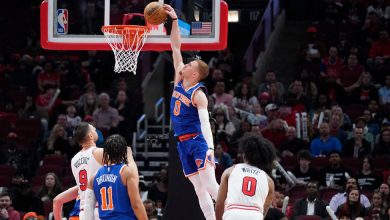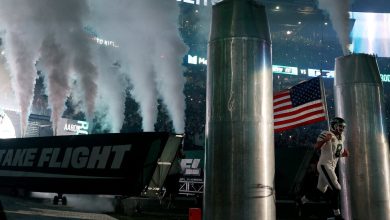He Thought He Made N.B.A. History. All He Got Was 3 Points.

For more than a decade, Kevin Grevey thought he was the first player in N.B.A. history to make a 3-pointer.
“It’s pretty amazing that I didn’t make the first one,” Grevey, 68, said recently. “Because I think the first time I touched the ball I caught it in the corner and toed behind the line, shot it and made it.”
It was Oct. 12, 1979, and Grevey’s Washington Bullets were opening their season against the Philadelphia 76ers. After the game, a reporter told him he’d “just set a record that would never be broken.”
All these years later he still isn’t totally sure he didn’t.
The league produced a news release, but only three days later to recap the first weekend of N.B.A. 3-pointers. It said Chris Ford of the Boston Celtics made the first 3-pointer in league history, by virtue of playing against the Houston Rockets in “the first games according to start time” that season. While it’s unclear exactly at what time each 3-pointer occurred, Ford’s game started 35 minutes before Grevey’s.
It would be a while before the news reached Grevey.
The 3-pointer was a novelty at the time. No one knew it would someday change the game. Decades later, Golden State guard Stephen Curry turned it into magic. This week he became the N.B.A.’s career leader in 3-pointers made, eclipsing Ray Allen, who had been the record-holder since 2011.
“It’s an event, just watching him,” said Mike Dunleavy Sr., who took his grandchildren to watch Curry shoot 3s before a game this fall.
The shot’s history in the N.B.A., though, began unceremoniously.
“At one point I was on the rules and competition committee and everybody had different thoughts about it,” Dunleavy said. “But the very beginning, I think people were leery of it.”
The 1979-80 season was intended to be a one-year trial for the 3-pointer in the N.B.A. The American Basketball Association had used it from its inception in 1967 until its merger with the N.B.A. in 1976.
In the book “Loose Balls: The Short, Wild Life of the American Basketball Association” by Terry Pluto, Pat Boone, a part owner of the Oakland Oaks, recalled the team’s introductory news conference.
“We had a demonstration of the 3-point shot and introduced a couple of the players we had signed, although I can’t recall who,” Boone said. “We then had a shooting contest and I won, which I guess should have told me we were in real trouble. Actually, the players weren’t used to shooting from 25 feet.”
Boone liked 3s, he said, because he was too short to go inside. Curry recently told USA Today that he, too, initially began working on 3s because of his smaller stature.
The A.B.A.’s adoption of the shot, though, wasn’t motivating for the N.B.A. The A.B.A. had all sorts of trappings then considered too absurd for the N.B.A. In addition to the 3-point shot, the A.B.A. had musical effects, a red, white and blue basketball, and cheerleaders.
“The N.B.A. for years frowned on the 3-point shot because it was going to tell guys to go outside as opposed to historically it was, ‘Get as close to the basket as fast as you can for the easy shot,’ ” said M.L. Carr, a former Celtics forward. “That was what they did in that funny league called the A.B.A.”
Carr started his career in the A.B.A., and felt proud when the N.B.A. finally accepted the 3-pointer. He played for the Celtics from 1979 to 1985 and remembered resistance, including from Red Auerbach, then a Celtics executive.
Grevey said he remembered that some coaches were “appalled about it.”
“They were like, ‘Well, the next thing they’re going to do is we’re going to be playing with that red, white and blue basketball,” he said.
In some arenas, Grevey said, the 3-point line was taped onto the court, making it temporary. Sometimes, that tape was in the wrong place.
“Somebody would say that looks farther,” said Rudy Tomjanovich, who played for the Houston Rockets throughout the 1970s and is now in the Hall of Fame. “They’d tell the coach or somebody. They’d look into it, have a measure and say, ‘Sure enough, it’s a foot longer than it used to be.’”
It took a while before players became proficient at the shot; it took eight years before the league average improved to 30 percent. By contrast, today’s players make about a third of their 3s, with the best shooters converting better than 40 percent of their attempts.
That meant rarely did teams run plays designed to end with a 3. Only in cases of double-digit deficits — desperate times — were 3-pointers acceptable to some coaches.
“If you had taken it under normal circumstances, most coaches would put you on the bench,” said Rick Barry, who spent four seasons in the A.B.A. and attempted 237 3-pointers in 1971-72, his final year in that league.
Barry, a Hall of Famer who was playing for the Rockets in 1979-80, said he remembered “nothing” about the first official 3-pointer, even though he played in that game against Ford’s Celtics. He hardly remembered his own 3-pointer that day. He was one of six players to make one on Oct. 12, 1979.
Tomjanovich, when told recently that he was on the court for the first-ever N.B.A. 3-pointer, was delighted to learn that bit of trivia.
Dunleavy knew.
“For the guys that could shoot, it was kind of cool,” said Dunleavy, who led the league in 3-point percentage in the 1982-83 season, at 34.5 percent. “Like, OK, you’re going to come into the game and be the first guy to make the shot.”
When Tomjanovich was told recently about Dunleavy’s plans, he quipped: “That ambitious son of a gun.”
Dunleavy was guarding Boston’s Tiny Archibald, who passed the ball to Ford behind the arc. Ford elevated above the outstretched hand of Robert Reid and sank a 3-pointer with 3 minutes 48 seconds left in the first quarter.
“The team was pretty excited that Chris opened a new era,” Carr said. “I guarantee if you interviewed Chris now he would say, ‘I didn’t realize what I was starting.’”
The game, better known for Larry Bird’s N.B.A. debut, didn’t stop. Newspaper accounts barely mentioned the first 3. There weren’t daily N.B.A. shows or podcasts to debate the rule change.
The Boston Globe noted the shot in a parenthetical, saying that “the Celtics led from 19-17 until the final buzzer (the lead coming on Ford’s history-making three-point bomb, the first ever for the Celtics).”
Willie Smith also made one for the Cleveland Cavaliers against the New Jersey Nets, and Paul Westphal and Don Buse made two each for the Phoenix Suns against Golden State. The reports of their feats by The Associated Press and The Daily News made no mention of their historic nature.
Grevey’s 3-pointer was described as “the first three-point play” by The Evening Sun, a Baltimore paper.
Grevey said he didn’t think about his first N.B.A. 3-pointer again until more than a decade later when he ran into the reporter who had told him he’d made history in 1979. The reporter shared that Ford was being credited with the first N.B.A. 3-pointer and that he planned to investigate.
Grevey shrugged.
“I swear I don’t care,” Grevey said in a recent phone interview.
He laughed, and then he marveled at how, at the time, few others cared much either.



